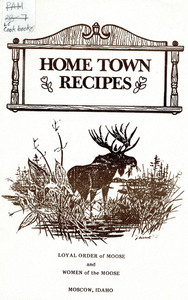Cooking for Connection
- LCHS

- Feb 10, 2023
- 7 min read
This article first appeared in the January/February 2023 edition of Home & Harvest magazine.
By Hayley Noble, Executive Director
‘Tis the time of year when we at LCHS discuss historical sources and the many ways historians use those sources. We’ve written about letters, the census, oral histories, journals, and many more – now it’s time to examine cookbooks and recipes as historical documents.
Food has long been a central part of heritage and cultural practices, and it remains that way for many people. Mealtime gatherings are staples in our holidays and traditions: 4th of July barbecues, Thanksgiving dinner, and Christmas feasts to name a few. If we are lucky, many of those times include family and friends, and feature our favorite recipes. For some, those recipes could be passed down or serve as a reminder of relatives and where we come from. I’m sure I’m not the only one with fond memories of baking cookies with my grandmother, using her favorite recipe that I still reach for today. It helps me feel closer to her since she’s passed and reminds me of a different time. My family still brings out a 1950s jell-o, cream cheese, marshmallow “salad” that was a treasured piece of my dad’s holidays growing up. While these cookie and “salad” recipes are not indicative of my cultural past, for many, passed down recipes are a way to honor their roots and remember relatives.

Now I feel I should also differentiate between cookbooks, community compilations, and family recipes. Cookbooks are those that are widely published and not necessarily regionally specific. Their contents can reflect historical events and national trends, but do not generally represent individual communities. Most of this article is in reference to family recipes and community compilations. All have their uses, but the latter two are the primary focus. My use of the word “cookbook” can mean both community compilations and widely published volumes.
Beloved recipes when compiled into cookbooks become valuable primary source historical documents. They can inform about national trends, materials available, and current technologies. Speaking of jell-o once again – it rose to prominence in the 1930s as the country was gripped by the Great Depression. Cheap and needing few ingredients, jell-o made meals easier and provided a way to stretch food to help families struggling to make ends meet. Those children growing up in the Depression are the ones creating these jell-o salads so typical of the 1950s. The 1940s saw the rise of Spam with a nation focused on wartime production and rationing. Meat was difficult to ship and store. Spam provided an alternative that was mass-produced and canned, did not need refrigeration, and was cheap to buy. Both the military and housewives saw the potential that Spam could be. Cookbooks from World War II included Spam, but also other ways to substitute meat and accounted for rationed ingredients like sugar and butter. More information on rationing can be found in the March/April 2021 edition of Home & Harvest Magazine and in this blog post.

Currently, American food trends are flooded with dietary restrictions. Some folks are vegetarian or vegan for animal welfare causes or green reasons, while many practice restrictive diets due to food allergies, such as lactose intolerance or celiac disease, among others. We cannot predict what future researchers will conclude about our era of food history, but what cannot be ignored are the ingenuity and science behind food. In the past, if you felt sick after eating something, you just did not eat it again. Now lactose intolerance is an inconvenience, but just about everyone can still enjoy a latte with a milk substitute, or ice cream with short-lived medication. Gluten-free menu items are gaining popularity and meat substitutes abound to accommodate these health and social issues. Who knows – maybe one day your grandchild will treasure your favorite dairy-free recipe for their holiday baking. Not surprisingly, the current rise of diet culture has meant a plethora of cookbooks touting weight-loss and other “healthy benefits.” This example illustrates American fatphobia and the toxic ideas surrounding weight, self-worth, and beauty standards. Diet culture has also been responsible for the increase in disordered eating and negative societal conditioning, especially when it comes to women. These diet cookbooks display the confluence of capitalism, privilege, and the unattainable beauty standards that most people strive for.
Culturally speaking, meals and cooking are one of the most popular ways to experience other cultures. Globalization has made regionally unique ingredients widely available for use in various dishes. Historically, spices have been coveted items reserved for the wealthy. While still expensive, spices provide the unique flavor combinations that different cultures are famous for: masala in South Asia, Adobo in Latin America, and Shichimi in Japan. After immigrating, many families adapt their original recipes to fit their new lives elsewhere. The evolution of those changes speaks to the melding and mixing of families and cultures as globalization increases and travel becomes more affordable. Those regionally specific ingredients serve as a reminder of where one comes from and connects them to those roots. Those limitations in ingredients can also serve as educational tools. I remember learning about the Oregon Trail and baking molasses cookies for my class. The idea was to show that things like eggs were not readily available. All you had were the shelf-stable goods acquired along the way, like flour and molasses - a cheaper alternative to sugar.

Colloquially, most are already familiar with recipes that prohibit certain ingredients in terms of religion. It is common knowledge that Hinduism prohibits beef and encourages vegetarianism, Islam promotes sober lifestyles and has special laws dictating what can and cannot be consumed, and Judaism subscribes to kosher rules. All of these religions and others have various interpretations, but all influence the types of recipes included in cookbooks from those regions or populations. Additionally, cookbooks usually contain a multitude of recipes for use in the everyday as well as special occasions, varying perspectives on what was reserved for holidays versus what was seen as mundane and used daily.

One of the most fun ways that the Latah County Historical Society has utilized cookbooks is in the Latah County Fair Recipe Challenge in 2021 and 2022. In the challenge, LCHS staff chose a recipe from one of our historic cookbooks and challenged bakers to make the recipe, then staff tasted all entries, picking a winner. The two recipes chosen thus far did not specify flavor, how much flour to use, or the temperature and time to bake. Many of the recipes in similar cookbooks do not include those details either. That is because, before modern stoves, many baked in wood burning iron ovens that varied in temperature depending on the kind of wood used. Other factors included altitudes, humidity, and pans used, which are still factored into baking today. Not everyone was going to have the same oven, wood, or pans available, so bakers had to tailor recipes to their own needs. As technology improved, kitchens ditched wood burning stoves for gas and electric. By the late 1920s, most new homes were built with electric or gas stoves/ovens. With so much variation, you could not rely on the time to bake being consistent with different appliances in use and various other factors.
Many of the cookbooks included in the LCHS Collection come from ladies’ groups and organizations associated with area churches. For example, the cookbook put together by the Lutheran Church contains many Swedish recipes, owing to the fact that most Lutheran families in the area had ties to Sweden. The collection contains books from different Moscow churches, civic clubs and service organizations, granges, sororities, local companies like the Washburn-Wilson Seed Company and Idaho Pea and Lentil Commission, music ensembles, Moscow library patrons, and others. These collaborative cookbooks detailed multiple family and community practices inherent to that group. Many feature regional ingredients such as peas, lentils, and huckleberries. So many women’s groups throughout the twentieth century illustrate how upper class women undertook different charity and community based efforts, many of which have cookbooks in our collection: The Women’s Civic Improvement Club of Bovill, church ladies’ aid societies, Women’s Club of Viola, Dry Creek Welfare Club, Moscow Jaycee Ettes, and the Ladies of the W. H. M. Society in Troy.
It’s no surprise that most of the community cookbooks come from women. Historically, housewives have been the cooks, while commercial kitchens were run by men. This division references the divided gender roles between the domestic and the public spheres that persist in society today. Now, anyone can cook, but the patriarchal expectations run deep and influence social understanding of “women’s work.” The language in cookbooks captures those ideas quite well and one can view the evolution of our gendered ideas of who is in the kitchen. Of course, society today has vastly improved, but these gender roles continue to permeate society and criticize women who do not fit the typical “housewife” imagery that cookbooks perpetuated for generations. Some of the early twentieth century books also contain etiquette tips and hints to host the best gatherings, complete with decor suggestions, recipes, manners, and invitation language. All so the hostess can throw the best party.
Of course, food and culture is a vast topic for discussion, and I merely skimmed the top. But hopefully this short insight has illustrated how cookbooks are, in fact, historical documents containing clues about the past and how current trends may be documented. Cookbooks can inform ideas about religious practices, historical events, materials available, immigrant experiences, technological capabilities, and the evolution of our gendered perception of “women’s work.” Cookbooks are also practical ways that students can learn about history and heritage. Cooking from historic recipes brings up questions or challenges that we no longer face. Perhaps most importantly, cookbooks can connect use to our ancestors in truly unique ways. Cooking a relative’s favorite recipe honors them and the culture that we came from.
All cookbooks are from LCHS Collection: LC Cookbooks.






















Comments